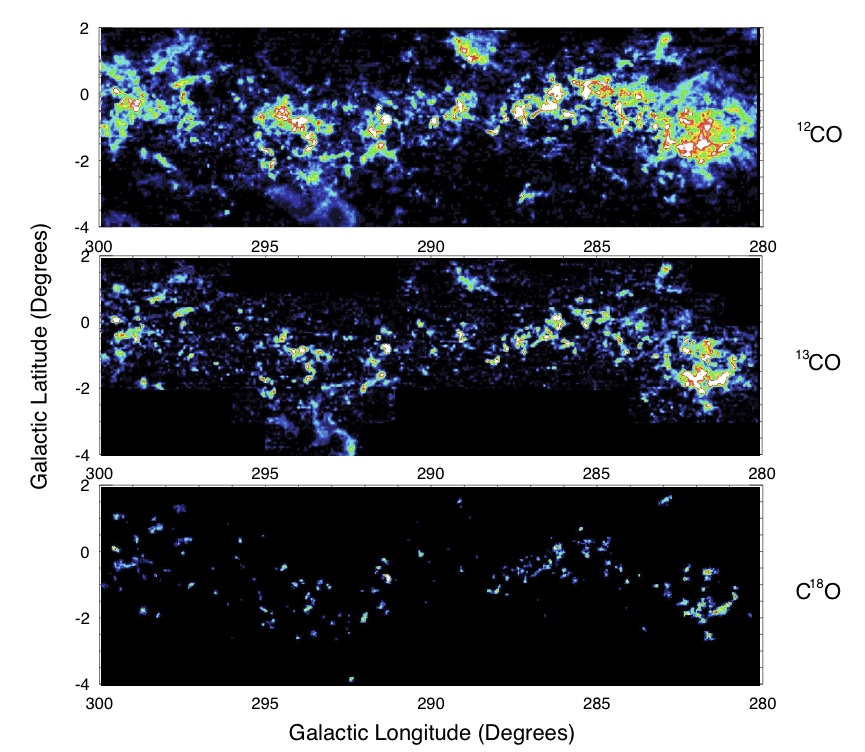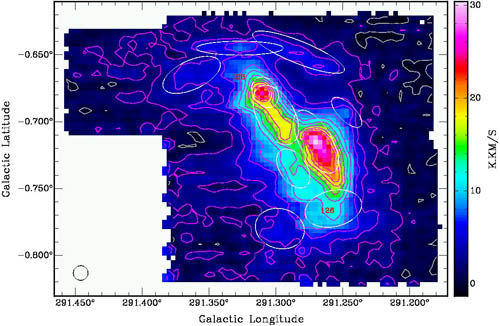What is CHaMP?
Stars are born from collapsing cores of gas and dust inside vast molecular clouds scattered across the disk of our Milky Way galaxy. An accurate understanding of this process is essential for comprehending the evolution of galaxies, the regulation of their interstellar media, and the initial properties of the resulting stars and planets — all clues to our cosmic origins. However, star formation is a complex process. Many competing forces, such as gravity, magnetic fields, turbulence and stellar feedback, clash over a wide range of scales. Especially for massive stars and star clusters, the triple obstacle of a larger average distance (compared to the more common low-mass star forming clouds), the speed of their evolution, and the chaos of their natal environment, has hampered development of theoretical models and a global understanding of the star formation activity of entire galaxies. To make progress, large-scale, systematic, and unbiased observational surveys of the all the stages of the star formation process are essential.
CHaMP is such a survey, involving two main stages. First, observing with the Nanten (Chile) and Mopra (Australia) radio telescopes, the CHaMP team used a novel recursive mapping technique that systematically probes higher and higher densities to build up a large, unbiased survey of dense molecular gas cloud clumps in the Milky Way. All Galactic star formation is expected to occur in such clumps. Second, these clumps are being followed up with a wide range of observations, such as in the infrared, to characterise their star formation activity. In this way we are building up a complete picture of all stages of the star formation process, robustly connecting the relatively diffuse interstellar medium to the giant molecular clouds to their dense gas clumps to their collapsing cores to the new-born stars.
CHaMP began with a large area (20°×6°) of the southern Milky Way in Centaurus, Carina, and Vela. The Nanten telescope made complete, but lower-resolution, maps of this area in a number of molecular spectral lines, which trace the cold, dense gas where stars are forming in our Galaxy. The carbon monoxide molecule in particular is a useful tracer: see Figures 1–3.

Figs. 1–3: Nanten integrated intensity images of CO isotopologues. The sequence 12CO -> 13CO -> C18O samples progressively denser molecular gas environments for the same line brightness. Thus 12CO maps can serve as finder charts for 13CO emission, and 13CO for C18O. Active star formation only occurs within the C18O emission, despite the 12CO being very widespread. Therefore the Nanten C18O, and similiar HCO+ maps, can serve as finder charts for most, if not all, star formation within this window.
The Mopra dish near Coonabarabran (part of the Australia Telescope) mapped these cold, massive clouds at much higher resolution, and simultaneously in a number of molecular spectral lines. Looking at different molecules lets us understand the physical processes that dominate the star formation activity we see: see Figures 4 & 5. Most significantly, since we are surveying a large number of clouds in the whole area in a uniform way, we will be able to look at the population of protostars, and derive lifetimes and other physical parameters that would not otherwise be possible.

Fig. 4 Sample Mopra HCO+ map of NGC 3576

Fig. 5 Sample Mopra N2H+ map of NGC 3576, with HCO+ contours from Fig. 4.
We are also using other telescopes around the world to complete this "big picture" view of massive star formation, including near-IR observations with the Anglo-Australian Telescope, Gemini-South, CTIO's Blanco telescope, and ESO's Very Large Telescope. With these facilities we image the young stellar clusters, and the hot gas they produce, that are the end product of gravitational collapse in the molecular clouds. Additionally, using data from the Spitzer Space Telescope and the Herschel Space Observatory, we will look at the temperature evolution of the cold gas as gravity compresses and heats the clumps that will become protostars.
Funding Acknowledgements





From 2005 to 2008, CHaMP was partially supported by Denison travel grants through the Science Foundation for Physics at the University of Sydney.
From 2008 to 2017, CHaMP was partially supported by NSF grants AST-0645412 and AST-1312597.
From 2012 to 2016, CHaMP was partially supported by a Spitzer Cycle 8 grant.
From 2015 to 2019, CHaMP was partially supported by NASA-ADAP grant NNX15AF64G.
From 2016 to 2022, CHaMP was partially supported by SOFIA grants in Cycles 4, 7, and 9.
More Information
For more information click the links on the sidebar above, or contact Peter Barnes
